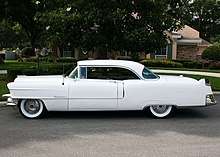Coupé
A coupé or coupe is a passenger car with a sloping or truncated rear roofline and generally two doors (although several four-door cars have also been marketed as coupés).
_coupe_(2017-07-15)_02.jpg)
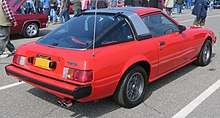
Coupé was first applied to horse-drawn carriages for two passengers without rear-facing seats.[1] The term coupé comes from the French translation of "cut".[2]
Etymology and pronunciation
Coupé (French: [kupe]) is based on the past participle of the French verb couper ("to cut") and thus indicates a car which has been "cut" or made shorter than standard.[2] It was first applied to horse-drawn carriages for two passengers without rear-facing seats.[1] These berlines coupés[3] or carosses coupés ("clipped carriages") were eventually clipped to coupés.[4]
There are two common pronunciations in English:
- /kuːˈpeɪ/ (koo-PAY) — the anglicized version of the French pronunciation of coupé.
- /kuːp/ (KOOP) — as a spelling pronunciation when the word is written without an accent.[4][5] Commonly used in the United States,[6] this change occurred gradually before World War II[7] and features in the Beach Boys' hit 1963 song "Little Deuce Coupe".
Definition
A coupé is fixed-roof car with a sloping rear roofline and one or two rows of seats. However, there is often debate surrounding whether a coupe must have two doors[8][9][10] or whether cars with four doors can also be considered coupés.[11] This debate has arisen since the early 2000s, when four-door cars such as the Mazda RX-8 and Mercedes-Benz CLS-Class have been marketed as "four door coupés" or "quad coupés".
In the 1940s and 1950s, coupes were distinguished from sedans by their shorter roof area and sportier profile.[12] Similarly, in more recent times, when a model is sold in both coupé and sedan body styles, generally the coupe is sportier and more compact.[13][1][14]
The 1977 version of International Standard ISO 3833— Road vehicles - Types - Terms and definitions— defines a coupé as having two doors (along with a fixed roof, usually with limited rear volume, at least two seats in at least one row and at least two side windows).[15] On the other hand, the United States Society of Automotive Engineers publication J1100[16] does not specify the number of doors, instead defining a coupe as having a rear interior volume of less than 33 cu ft (934 L).[13][1][17]
The definition of coupé started to blur when manufacturers began to produce cars with a 2+2 body style (which have a sleek, sloping roofline, two doors, and two functional seats up front, plus two tiny seats in back).[18]
Some manufacturers also blur the definition of a coupé by applying this description to models featuring a hatchback or a rear door that opens upwards.[19][20] Most often also featuring a fold-down back seat, the third door or hatchback layout of these cars improves their practicality and cargo room.[21]
Horse-drawn carriages
The coupé body style originated from the berline horse-drawn carriage. In the 18th century, the coupé version of the berline was introduced, which was a shortened ("cut") version with no rear-facing seat.[22][23][3][24] Normally, a coupé had a fixed glass window in the front of the passenger compartment.[25] The coupé was considered an ideal vehicle for women to use to go shopping or to make social visits.[26]
History
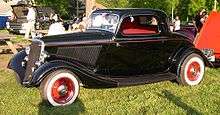
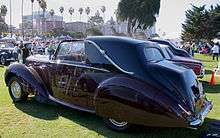
The early coupé automobile's passenger compartment followed in general conception the design of horse-drawn coupés,[27] with the driver in the open at the front and an enclosure behind him for two passengers on one bench seat.[28][29] The French variant for this word thus denoted a car with a small passenger compartment.[27]
By the 1910s, the term had evolved to denote a two-door car with the driver and up to two passengers in an enclosure with a single bench seat.[30][31] The coupé de ville, or coupé chauffeur, was an exception, retaining the open driver's section at front.[32]
In 1916, the Society of Automobile Engineers suggested nomenclature for car bodies that included the following:[31][33]
Coupe: An enclosed car operated from the inside with seats for two or three and sometimes a backward-facing fourth seat.
Coupelet: A small car seating two or three with a folding top and full height doors with fully retractable windows.
Convertible coupe: A roadster with a removable coupé roof.
During the 20th century, the term coupé was applied to various close-coupled cars (where the rear seat that is located further forward than usual and the front seat further back than usual).[34][35]
Since the 1960s the term coupé has generally referred to a two-door car with a fixed roof.[36]
Since 2005, several models with four doors have been marketed as "four-door coupés", however reactions are mixed about whether these models are actually sedans instead of coupés.[37][38][39] According to Edmunds, an American automotive guide, "the four-door coupe category doesn't really exist."[40]
Variations
Manufacturers have used the term "coupé" with reference to several varieties, including:
Berlinetta
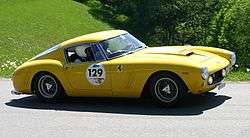
A berlinetta is a lightweight sporty two-door car, typically with two-seats but also including 2+2 cars.[41]
3 door coupé
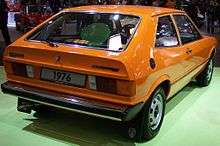
Particularly popular in Europe, many cars are designed with coupé styling but a 3-door hatchback layout to improve practicality, including cars such as the Alfa Romeo Brera[42], Ford/Mercury Cougar[43] and Volkswagen Scirocco.[44]
Business coupe

A two-door car with no rear seat or with a removable rear seat intended for travelling salespeople and other vendors carrying their wares with them. American manufacturers developed this style of coupe in the late 1930s.[45]
Club coupé
.jpg)
A two-door car with a larger rear-seat passenger area,[1] compared with the smaller rear-seat area in a 2+2 body style.
Combi coupé
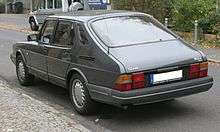
Saab used the term combi coupé for a car body similar to the liftback.[46]
Four-door coupé / Quad coupé
_Facelift_front_20100918.jpg)

A four-door car with a coupé-like roofline at the rear. The low-roof design reduces back-seat passenger access and headroom.[47] The designation was first used for the low-roof model of the 1962–1973 Rover P5,[48] followed by the 1992–1996 Nissan Leopard / Infiniti J30.[49] Recent examples include the 2005 Mercedes-Benz CLS, 2010 Audi A7 and 2012 BMW 6 Series Gran Coupé.[50][51][52]
Similarly, several cars with one or two small rear doors and no B-pillar have been marketed as "quad coupés". For example 2003 Saturn Ion and 2003 Mazda RX-8.
Opéra coupé
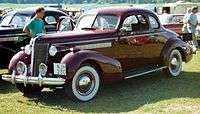
A two-door designed for driving to the opera with easy access to the rear seats. Features sometimes included a folding front seat next to the driver[53][54] or a compartment to store top hats.[55]
Often they would have solid rear-quarter panels, with small, circular windows, to enable the occupants to see out without being seen. These opera windows were revived on many U.S. automobiles during the 1970s and early 1980s.[56]
Three-window coupé
.jpg)
The three-window coupé (commonly just "three-window") is a style of automobile characterized by two side windows and a backlight (rear window). Front windscreens don't count. The style was popular from the 1920s until the beginning of World War II. While many manufacturers produced three window coupés, the 1932 to 1936 Ford is a particular favorite of hot rodders. The three-window coupé has a distinct difference from the five-window coupé, which has an additional window on each side.
Positioning in model range
In the United States, some coupés are "simply line-extenders two-door variants of family sedans", while others have significant differences to their four-door counterparts.[57] The AMC Matador coupe (1974–1978), had a distinct design and styling, sharing almost nothing with the 4-door versions.[58] Similarly, the Chrysler Sebring and Dodge Stratus coupes and sedans (late-1990 through 2000s), had little in common except their names, with the coupes engineered by Mitsubishi and built in Illinois, while the sedans were developed by Chrysler and built in Michigan.[59]
Coupés may also exist as model lines in their own right, either closely related to other models but named differently – such as the Alfa Romeo GT – or have little engineering in common with other vehicles from the manufacturer – such as the Toyota GT86.
See also
| Wikimedia Commons has media related to Coupes. |
References
- Adolphus, David Traver (March 2007). "Club Coupes - If you think you know what a Club Coupe is, think again". Hemmings Classic Car. Retrieved 14 July 2018.
- "Coach Building Terminology". Coachbuilt.com. 2004. Retrieved 14 July 2018.
- Haajanen, Lennart W. (2003). Illustrated Dictionary of Automobile Body Styles. Illustrations by Bertil Nydén. Jefferson, NC: McFarland. pp. 16, 18, 20, 50. ISBN 0-7864-1276-3. LCCN 2002014546.
- "coupé, n.3", Oxford English Dictionary, Oxford: Oxford University Press, 1893.
- "coupé", Merriam-Webster Dictionary, Springfield: Merriam-Webster and pronounced as one syllable.
- "Porsche Actually Made a Video on How to Pronounce Its Name". www.roadandtrack.com. Retrieved 13 April 2018.
- Mencken, Henry L. (1936). The American Language (4th ed.). p. 347.
I have... heard... coop for coupé
- "For the Last Time, a Coupe Is a Car With Two Doors". www.autotrader.com. Retrieved 16 April 2018.
- "A Sedan or a Coupe: What's the difference?". www.middletownhonda.com. Retrieved 16 April 2018.
- "Range Rover's $295K Coupe SUV Proves No Niche Is Too Small". www.wired.com. Retrieved 16 April 2018.
- "Sedan vs. Coupe Cars: Meaning, Definition & Differences". www.automoblog.net. Retrieved 16 April 2018.
- Breitenstein, Jeff (2004). The ultimate hot rod dictionary : a-bombs to zoomies. Motorbooks International. p. 55. ISBN 9780760318232. Retrieved 22 April 2015.
- "Coupe – Coupe Body Style – Two Door Coupe". autobytel.com. Retrieved 22 April 2015.
- "Coupé". Random House Kernerman Webster’s College Dictionary. 2010. Retrieved 22 April 2015.
- Technical Committee ISO/TC22, Road vehicles (1976), written at Geneva, Switzerland, ISO 3833-1977: Road vehicles – Types – Terms and definitions (ISO International Standard) (Second ed.), Switzerland: International Organization for Standardization (published 1 December 1977), Clause 3.1.1.5
- "J1100: Motor Vehicle Dimensions - SAE International". www.sae.org. Retrieved 20 April 2019.
- "What is a coupe?". www.ateupwithmotor.com. 17 September 2008. Retrieved 20 April 2019.
- Weber, Bob (26 August 2017). "What is the difference between coupe and sedan?". Chicago Tribune. Retrieved 14 July 2018.
- "hatchback - definition by the Free Online Dictionary, Thesaurus and Encyclopedia". Thefreedictionary.com. n.d. Retrieved 19 February 2020.
- "Hatchback - Definition from the Free Merriam-Webster Dictionary". Merriam-webster.com. Retrieved 19 February 2020.
- Collins, Dan (4 February 2020). "Best Hatchbacks". Carbibles. Retrieved 19 February 2020.
- Adolphus, David Traver (March 2007). "Club Coupes - If you think you know what a Club Coupe is, think again". Hemmings Classic Car. Retrieved 30 March 2020.
Coupé (some designers still insist on the 'koo-pay' pronunciation) is the French verb meaning 'to cut,' and it was first applied to 19th Century carriages, where the rear-facing seats had been eliminated, or cut out.
-
Haajanen, Lennart W. (2017) [2003]. Illustrated Dictionary of Automobile Body Styles (2nd ed.). Jefferson, North Carolina: McFarland. p. 52. ISBN 9780786499182. Retrieved 30 March 2020.
When the Berline body was shortened the Berline Coupe, or just Coupe, resulted.
- "Royal carriages". www.kreml.ru. Retrieved 14 April 2018.
- Haajanen 2003, p. 50.
-
Stratton, Ezra (1878). "Chapter VIII. French carriages, including historical associations". World on Wheels. New York. p. 242. ISBN 0-405-09006-4. Retrieved 4 September 2014.
For the use of ladies making calls or engaged in shopping, no better carriage has yet been invented.
- Haajanen, Lennart W. (2018). Illustrated Dictionary of Automobile Body Styles (Second ed.). McFarland. pp. 52–53, 57. ISBN 9781476624044. Retrieved 14 July 2018.
- Haajanen 2003, p. 51.
- Clough, Albert L. (1913). A dictionary of automobile terms. The Horseless Age Company. p. 89. Retrieved 17 May 2015.CS1 maint: ref=harv (link)
- Clough 1913, p. 89.
- "What's What in Automobile Bodies Officially Determined". The New York Times. 20 August 1916. Retrieved 22 April 2015.
Here it is, with other body types and distinctions, officially determined recently by the Nomenclature Division of the Society of Automobile Engineers
- Haajanen 2003, pp. 51, 55-56.
- Forbes, Kingston (1922). The Principles of Automobile Body Design: covering the fundamentals of open and closed passenger body design. Ware Bros. p. 238. Retrieved 22 April 2015.
- Clough 1913, p. 33.
- Beattie, Ian (1977). The Complete Book of Automobile Body Design. Yeovil, UK: The Haynes Publishing Group. p. 17. ISBN 0854292179.CS1 maint: ref=harv (link)
- "Sedan vs. Coupe: What's the Difference?". www.carmax.com. Retrieved 14 April 2018.
- "Car Review: 2005 Mercedes-Benz CLS 500". www.driving.ca. Retrieved 14 April 2018.
- "2018 Mercedes-Benz CLS Class Review". www.thecarconnection.com. Retrieved 14 April 2018.
- "2005 Mercedes-Benz CLS 500 - First Look". www.superstreetonline.com. Retrieved 14 April 2018.
- Montoya, Ronald (28 May 2013). "Defining Vehicle Types". Edmunds. Retrieved 14 July 2018.
- "Porsche 960 : une nouvelle berlinette à moteur flat-8". www.autonews.fr.
- https://www.autocar.co.uk/car-news/used-car-buying-guides/alfa-romeo-brera
- https://www.rac.co.uk/drive/car-reviews/ford/cougar/cougar-1998-2002/
- https://www.topgear.com/car-reviews/volkswagen/scirocco
- "Automotive History: Trying To Make (Business Coupe) Sense Of The Gremlin". www.curbsideclassic.com. Retrieved 14 April 2018.
- Jazar, Reza N. (2008). Vehicle dynamics: theory and applications. Springer-Verlag. p. 31. ISBN 978-0-387-74243-4. Retrieved 22 April 2015.
- Powell, Philip (8 January 2008). "The Fastback is Back Thanks to Mercedes, Audi, BMW, Volkswagen". Classical Drives. Archived from the original on 1 August 2013. Retrieved 22 April 2015.
- Langworth, Richard M. (1986). Complete book of collectible cars, 1930–1980. Random House Value Publishing. p. 389. ISBN 978-0-517-47934-6.
- "The Infiniti J30 Was A Four-Door Coupe Before It Was Fashionable". www.kinja.com. Retrieved 21 April 2019.
- Mercedes CLS-Klasse, Auto, Motor und Sport, retrieved 18 June 2011
- "Neuer Audi A7 Sportback: Erste Bilder, Details und Preise" [New Audi A7 sportback: First pictures, details and pricing] (in German). Heise. Retrieved 22 April 2015.
- Giuliani, Stefan (January 2011), Audi A7 Sportback 3.0 TDI quattro S tronic (DPF) (PDF) (in German), ADAC, retrieved 22 April 2015
- "Dictionary of Historic Automotive Terms". Chalk Hill Educational Media. Archived from the original on 14 May 2011. Retrieved 22 April 2015.
- Burness, Tad (2005). American Car Spotter's Bible 1940–1980. Krause Publications. p. 736. ISBN 978-0-89689-179-1. Retrieved 6 April 2010.
- "Archival Revival: One-of-a-kind Nash here a few more weeks". www.kenoshanews.com. Retrieved 28 April 2018.
- Frazee, Irving Augustus (1949). Automotive Fundamentals. American Technical Society. p. 81.
- Loh, Edward (February 2008). "Comparison: 2008 Honda Accord Coupe vs 2008 Mitsubishi Eclipse vs 2008 Nissan Altima Coupe (Front-wheel-drive coupe comparison)". Motor Trend. Retrieved 22 April 2015.
- Severson, Aaron (25 December 2009). "What's a Matador? AMC's Midsize Classic, Rebel, and Matador Coupe". ateupwithmotor.com. Retrieved 22 April 2015.
- Krebs, Michelle (18 February 2001). "Dodge Stratus and Chrysler Sebring; When Lightning Doesn't Strike Twice". The New York Times. Retrieved 22 April 2015.
